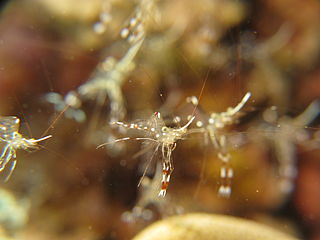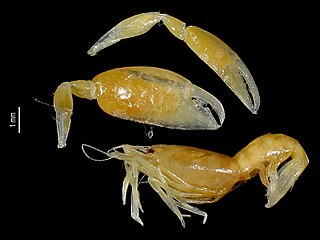
Lipke Bijdeley Holthuis was a Dutch carcinologist, considered one of the "undisputed greats" of carcinology, and "the greatest carcinologist of our time".

Palaemonidae is a family of shrimp in the order Decapoda. Many species are carnivores that eat small invertebrates, and can be found in any aquatic habitat except the deep sea. One significant genus is Macrobrachium, which contains commercially fished species. Others inhabit coral reefs, where they associate with certain invertebrates, such as sponges, cnidarians, mollusks, and echinoderms, as cleaner shrimps, parasites, or commensals. They generally feed on detritus, though some are carnivores and hunt tiny animals.

Macrobrachium is a genus of freshwater prawns or shrimps characterised by the extreme enlargement of the second pair of pereiopods, at least in the male.

Urocaridella antonbruunii, common names clear cleaner shrimp or red-white cleaner shrimp, is a species of shrimp belonging to the family Palaemonidae. It was described by A. J. Bruce in 1967. It is one of the species that are known as cleaner shrimps.

Cuapetes is a genus of shrimp in the family Palaemonidae, comprising the following species:

Ancylomenes is a genus of shrimp, erected in 2010 to accommodate the group of species around "Periclimenes aesopius". Members of the genus are widely distributed in the warm oceans of the world, and live in association with cnidarians; most are cleaner shrimp.

Palaemonella is a genus of shrimp in the family Palaemonidae, containing the following species:
Ancylomenes holthuisi is a species of marine shrimp in the family Palaemonidae. It was first described in 1969 by A.J. Bruce as Periclimenes holthuisi.

Tuleariocaris is a genus of shrimp comprising the following species:

Periclimenaeus is a genus of decapod crustaceans of the family Palaemonidae which is part of the infraorder Caridea. The genus was named by the English carcinologist Lancelot Alexander Borradaile in 1915. He set out the distinguishing features of the genus as:
Body rather stout, cephalothorax deep, a good deal compressed, abdomen greatly curved Thorax without dorsal swelling. Rostrum rather short, compressed, toothed above only. Outer antennular flagellum not deeply cleft. Antennal scale of good breadth. Mandible without palp. Second maxilliped without podopalp. Third maxilliped narrow, with vestigial arthrobranch.
Palaemon litoreus is a species of shrimp of the family Palaemonidae.

Palaemon pacificus is a species of shrimp of the family Palaemonidae.

Palaemon pandaliformis is a species of shrimp of the family Palaemonidae. It is found along with Palaemon northropi.

Periclimenes, commonly known as glass shrimp or cleaner shrimp, is a commensal and often symbiotic genus of semi-transparent shrimp within the family Palaemonidae. Species of this large genus feature a wide variety of coloration and patterns, widespread distribution throughout much of the world's tropical oceans, and are often sought out for aquarium trade.

Zenopontonia is a genus of shrimp within the family Palaemonidae.
Pontonia is a genus of shrimps belonging to the family Palaemonidae.
Charles Fransen is a zoologist from the Netherlands, specializing in shrimps.

Dactylonia is a genus of shrimp in the family Palaemonidae, first described by Charles Fransen in 2002.

Dactylonia monnioti is a small shrimp in the family Palaemonidae, first described by Alexander James Bruce. The species epithet honours Claude Monniot who was responsible for finding the species.












